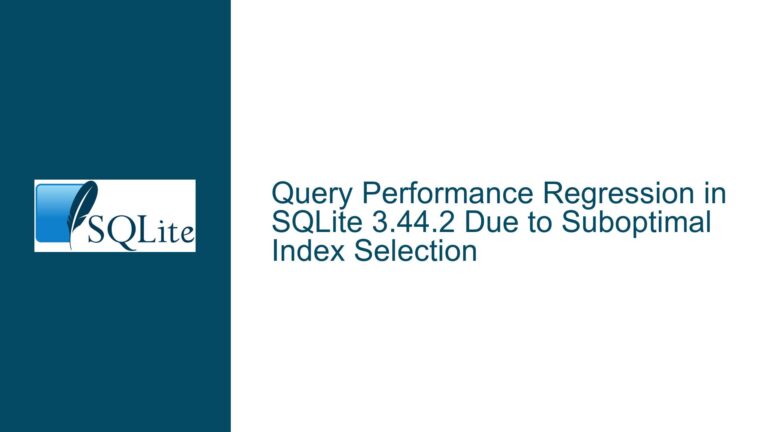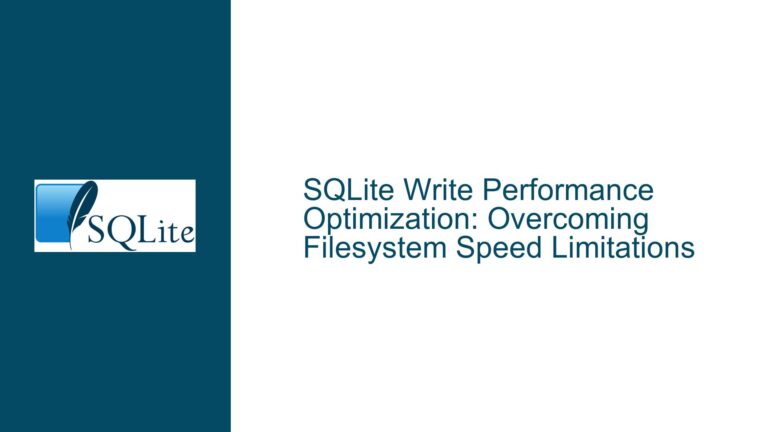Managing SQLite Heap Memory Growth and Application Restarts
Issue Overview: SQLite Memory Usage Spikes and Application Instability
The core challenge revolves around an application experiencing unexpected restarts due to SQLite-related heap memory growth. The original code executes a complex query using sqlite3_exec() with a callback function to process results. After processing, attempts are made to release memory using sqlite3_release_memory(), sqlite3_soft_heap_limit64(), and other memory management APIs. However, the device still restarts when heap usage grows from 2MB to 6MB.
Key technical elements at play:
- SQLite Memory Subsystem Behavior: SQLite uses a page cache for database operations, which retains memory even after queries complete. This cache isn’t automatically returned to the OS but remains in the process heap.
- Callback-Driven Result Processing: The
callBackTicketDataListfunction (not shown) likely allocates memory for result processing, which may not be properly released. - Memory Leak Patterns: Repeated execution of the query without proper cleanup of SQLite resources (statements, cursors) or application-side data structures.
- Heap Fragmentation: Aggressive memory release attempts may fragment the heap, exacerbating memory pressure.
Possible Causes: Why SQLite Operations Trigger Memory Exhaustion
1. Unreleased SQLite Resources
- Page Cache Retention: SQLite defaults to retaining up to 2,000 pages (~1.5MB with 768B pages) in the page cache. Large result sets or complex queries may cause this cache to grow.
- Unfinalized Statements: While
sqlite3_exec()automatically finalizes statements, mixing it with manualsqlite3_prepare_v2()/sqlite3_step()withoutsqlite3_finalize()leaks memory. - Transaction Scope Issues: Implicit transactions created by
sqlite3_exec()may hold locks and cache pages longer than necessary.
2. Application-Side Memory Leaks
- Callback Function Mismanagement: The
callBackTicketDataListfunction might retain parsed data (e.g., strings, structures) across invocations without freeing them. - String Stream Accumulation: The
sqlstring stream (<<operations) could create temporary objects that aren’t properly recycled. - Global/Static Variables:
intTotalTicketCountand other variables may accumulate state across transactions without reset.
3. Ineffective Memory Release Strategies
- sqlite3_release_memory() Misuse: This API only releases unused pages from the page cache to the SQLite heap, not to the OS. It doesn’t address leaks in application-managed memory.
- Soft Heap Limits:
sqlite3_soft_heap_limit64(250000)sets a recommended limit that SQLite may exceed under memory pressure. It doesn’t enforce hard limits. - Allocator Inefficiency: The default system allocator may fragment memory under high churn, making large contiguous blocks unavailable even if free memory exists.
4. Suboptimal Query Design
- Nested Subqueries: The
(SELECT strStageCode ...)subqueries execute repeatedly per row, multiplying memory usage. - Unbounded Result Sets: The
GROUP BY strTicketNoclause may generate more groups than expected if ticket numbers aren’t unique. - String Operations:
substr(strTicketNo,7)creates new string values that require temporary storage.
Troubleshooting Steps, Solutions & Fixes
Step 1: Identify and Eliminate Memory Leaks
A. Instrument Memory Tracking
- Pre-Execution Baseline: Use
sqlite3_memory_used()before/after critical sections:sqlite3_int64 before = sqlite3_memory_used(); // Execute query sqlite3_int64 after = sqlite3_memory_used(); printf("SQLite delta: %lld\n", after - before); - OS-Level Monitoring: On Linux, read
/proc/self/status(VmRSS) or usegetrusage(). On embedded systems, check vendor-specific APIs.
B. Audit Callback Function
Ensure the callBackTicketDataList callback:
- Frees Row Data: If using
sqlite3_malloc()for data copies, pair withsqlite3_free(). - Avoids Global Accumulation: Don’t append results to global lists without a cleanup mechanism.
- Handles Blobs/Text Carefully: For columns like
strStageCode, useSQLITE_STATICif data is read-only, orSQLITE_TRANSIENTto force copying.
C. Use Valgrind or AddressSanitizer
- Compile with Debug Symbols: Add
-gto CFLAGS. - Run Under Valgrind:
valgrind --leak-check=full --track-origins=yes ./your_appLook for:
- "Definitely lost" blocks (application leaks).
- "Still reachable" blocks (SQLite’s retained page cache).
- AddressSanitizer (ASAN):
export ASAN_OPTIONS=detect_leaks=1 ./your_app
Step 2: Optimize SQLite Memory Configuration
A. Configure Page Cache Size
- Reduce Cache Size Pragmatically:
sqlite3_db_config(db, SQLITE_DBCONFIG_DEFENSIVE, 1, 0); // Optional safety sqlite3_exec(db, "PRAGMA cache_size = -100;", 0,0,0); // 100KB cache - Monitor Cache Hit Ratio:
PRAGMA stats; -- Check 'cache_hit' vs 'cache_miss'If hit ratio is low, gradually increase cache size.
B. Enable MEMSYS5 Allocator
- Compile-Time Activation:
#define SQLITE_ENABLE_MEMSYS5Rebuild SQLite amalgamation.
- Initialize at Runtime:
sqlite3_config(SQLITE_CONFIG_HEAP, malloc(250000), 250000, 64); sqlite3_initialize();This caps SQLite’s heap usage at 250KB with 64-byte alignment.
C. Use Prepared Statements
Replace sqlite3_exec() with prepared statements for better control:
sqlite3_stmt *stmt;
const char *tail;
rc = sqlite3_prepare_v2(db, strquery.c_str(), -1, &stmt, &tail);
while (sqlite3_step(stmt) == SQLITE_ROW) {
// Process row
}
sqlite3_finalize(stmt); // Critical for memory cleanup
Step 3: Query and Schema Optimization
A. Flatten Nested Subqueries
Rewrite correlated subqueries as JOINs:
SELECT
TR.intTicketTypeID,
substr(strTicketNo,7),
...,
RSM_From.strStageCode AS FromStationStageCode,
RSM_To.strStageCode AS ToStationStageCode
FROM tblTicketTransactions TR
LEFT JOIN TBLROUTESTATIONMASTER RSM_From
ON RSM_From.intRouteID = TR.intRouteID
AND RSM_From.intStationID = TR.intFromStationID
AND RSM_From.bActive=1
AND RSM_From.bDeleted=0
LEFT JOIN TBLROUTESTATIONMASTER RSM_To
ON RSM_To.intRouteID = TR.intRouteID
AND RSM_To.intStationID = TR.intToStationID
AND RSM_To.bActive=1
AND RSM_To.bDeleted=0
...
This reduces per-row computation and temporary storage.
B. Add Covering Indexes
Create indexes to support the query’s WHERE, JOIN, and GROUP BY clauses:
CREATE INDEX idx_txn_waybill_trip
ON tblTicketTransactions(strWayBillNo, intTripID);
CREATE INDEX idx_route_station
ON TBLROUTESTATIONMASTER(intRouteID, intStationID)
WHERE bActive=1 AND bDeleted=0;
C. Limit Result Set Size
If the application doesn’t need all results at once:
sqlite3_exec(db, "PRAGMA max_page_count = 500;", 0,0,0); // Limit DB growth
// Use LIMIT/OFFSET in query
sql << "... ORDER BY dteTicketDateTime ASC LIMIT 100;";
Step 4: Application Architecture Adjustments
A. Batch Processing
Process tickets in chunks to avoid loading all data into memory:
int offset = 0;
const int LIMIT = 100;
do {
std::stringstream sql;
sql << "SELECT ... LIMIT " << LIMIT << " OFFSET " << offset;
// Execute and process
offset += LIMIT;
} while (intTotalTicketCount > 0);
B. Connection Pooling
Reuse database connections instead of opening/closing per query:
class SqliteManager {
std::vector<sqlite3*> pool;
sqlite3* acquire() {
if (pool.empty()) return openNewConnection();
sqlite3* db = pool.back();
pool.pop_back();
return db;
}
void release(sqlite3* db) {
sqlite3_reset(db); // Reset any active statements
pool.push_back(db);
}
};
C. Asynchronous Processing
Offload heavy queries to a background thread with a bounded queue:
std::queue<std::string> queryQueue;
std::mutex queueMutex;
// In background thread:
while (true) {
std::string query;
{
std::lock_guard<std::mutex> lock(queueMutex);
if (!queryQueue.empty()) {
query = queryQueue.front();
queryQueue.pop();
}
}
if (!query.empty()) {
// Execute and notify main thread
}
}
Step 5: Advanced Diagnostics and Mitigations
A. Use SQLITE_CONFIG_LOG
Enable SQLite’s internal logging to trace memory operations:
void sqliteLogCallback(void* pArg, int code, const char* msg) {
if (code == SQLITE_LOG_MEMORY) {
printf("SQLite memory op: %s\n", msg);
}
}
sqlite3_config(SQLITE_CONFIG_LOG, sqliteLogCallback, NULL);
B. Implement Custom Allocator
Override SQLite’s allocator to track usage:
void* myMalloc(int size) {
void* p = malloc(size);
atomic_add(&totalAllocated, size);
return p;
}
void myFree(void* p) {
atomic_sub(&totalAllocated, _msize(p));
free(p);
}
sqlite3_mem_methods methods = { myMalloc, myFree, ... };
sqlite3_config(SQLITE_CONFIG_MALLOC, &methods);
C. Hardware-Level Mitigations
For embedded devices:
- Increase Swap Space: Even a small swap file can prevent OOM restarts.
- Adjust OOM Killer Settings: On Linux, tweak
/proc/<pid>/oom_score_adj. - Memory Compression: Use zram or similar in-kernel compression.
By systematically addressing leaks, optimizing SQLite configuration, refining queries, and restructuring application logic, developers can stabilize memory usage and prevent device restarts. The key is combining SQLite’s built-in memory controls with rigorous application-side resource management.





